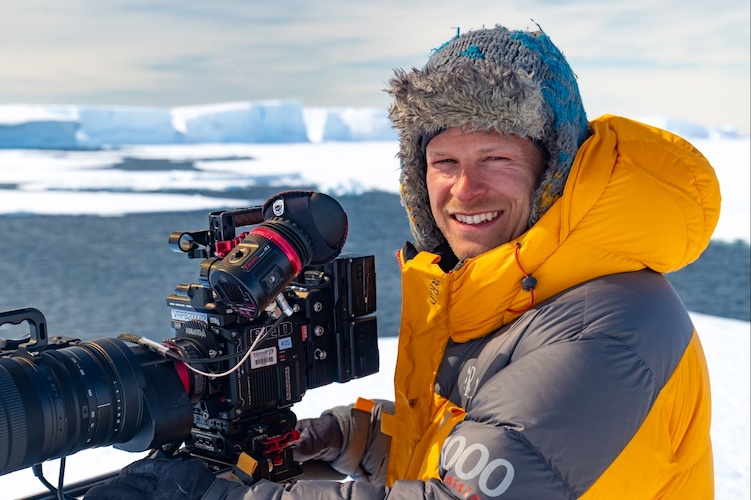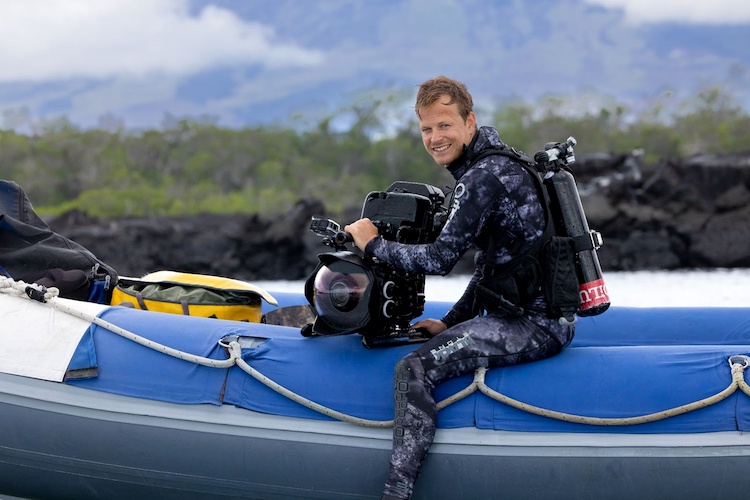Interview: Nat Geo Explorer Bertie Gregory Discusses "Secrets of the Penguins"
Just in time for Earth Day, National Geographic’s Secrets of the Penguins is now streaming on Disney+ and Hulu, inviting audiences on a breathtaking journey to the farthest corners of the planet to witness penguin behavior like never before. Narrated by Blake Lively and led by Emmy and BAFTA Award-winning explorer Bertie Gregory, the three-part series combines cutting-edge technology, stunning cinematography, and never-before-seen animal moments - including a viral cliff dive by emperor penguin chicks - to reveal what makes these resilient birds truly extraordinary. I caught up with Bertie Gregory to learn more about the filming challenges, the emotional highs and lows, and how audiences at home can help protect penguins and the planet.

Alex: Hi Bertie, congratulations on Secrets of the Penguins.
Bertie Gregory: Hey Alex, good to chat with you. Thank you very much, same to you.
Alex: Now I understand that you're also filming more Animals Up Close. I’m curious—where in the world are you right now?
Bertie Gregory: I’m actually in London. We've just started the press tour for Secrets of the Penguins, so very much not in the wild right now.
Alex: That’s awesome. I know Animals Up Close has taken you to the same region before. Did you have the benefit of any overlap—were you working on both at the same time or did you have to pause one to come to this?
Bertie Gregory: No, sadly not—separate trips. But of course, you know, experience is everything. And knowing what I was getting in for actually meant that I was pretty daunted starting on Secrets of the Penguins. Penguins have been filmed a lot before—not just by me but by lots of other people in very prominent nature documentaries. You know, March of the Penguins. I also know firsthand, and we've chatted about my previous encounters down there, that penguins live in difficult places to film—cold, far away, logistically challenging. And when you call a series Secrets of the Penguins, you’re setting expectations quite high.
But I’m pleased to report, after two years of filming—I was wrong. I thought I knew penguins. I don’t. Just when I thought they hit their limit, they go and do something mind-blowing. And that’s what the series is all about.
Alex: I understand you had a small crew. I’m assuming these are people you’ve worked with before? Did you have that kind of bond prior to filming this?
Bertie Gregory: It was a mix actually—some I’d worked with before, some not. But yeah, one of the best parts about my job is that as well as getting to hang out with cool animals, I get to hang out with cool people. We had an awesome, awesome team of specialists. While the teams in the field are very small because we want to be maneuverable and minimize our footprint on the landscape, the places these penguins live are really hard to get to. So the team is actually huge. It was a massive collaboration.
Alex: I’m curious about the technology that allows this kind of filmmaking to be done today—that’s different from when the True-Life Adventures started in the '40s. I know we’ve got some really impressive drone shots in the series, but what kind of tech helped make this series possible for you?
Bertie Gregory: Yeah, it was definitely easier to get there than in the '40s! Maybe less hard, rather than easier. As you mentioned, drones were a key kind of tool. We've been using drones in wildlife filmmaking for a few years now. They do have the potential—if flown incorrectly—to disturb the wildlife. So two key changes happened at the start of the project that made them really useful for us. One is increased flight time, which means we could hover in the air and wait for animal behavior to unfold. And second, they've now got more powerful zoom lenses, so we don't need to be close to get good shots—we can be that little bit further away. That was key.
I think the highlight of the series is when the emperor penguin chicks launched themselves off a huge 50-foot ice cliff. That was only possible because of drone technology. There was no way I was getting to where they were on foot—we were far away, and I was flying the drone out to where they were.
Alex: That specific clip was kind of the first teaser footage that we as consumers got from the series. I understand it went pretty viral over on TikTok. Is that weird for you—to have these short moments go viral when you’ve spent 274 days in the Antarctic?
Bertie Gregory: It’s not really a surprise that it did. I remember as soon as I filmed that, I was like, “Yeah, this is going to break the internet." I mean, not only is it penguins—and everyone loves penguins—they’re a 9-by-16 vertical-ready animal, so they’re made for social media. But also, there’s something very otherworldly about that ice cliff—sort of Game of Thrones. I think the reason it went as viral as it did was because it’s so relatable. We all experience vertigo. We can imagine what it would be like standing at the top of that cliff looking over the edge. So you instantly understand what is going on. There’s the reluctance of some penguins, but the confidence of others—and yeah, they just sent it off that cliff. Cool little birds.

Alex: You mentioned the pressure of this being part of an ongoing series—it’s called Secrets of the Penguins, so there’s an expectation of discovering something new. Were some of these behaviors already known, or were there things that just completely surprised you?
Bertie Gregory: The cliff jump was not on the script. We planned to film them jumping in the ocean the normal way—off of sea ice that’s one or two feet high. So yeah, sometimes they just reveal their secrets in the moment.
On the other hand, there were some secrets our amazing research team at Talesmith found. One of those was in the Galápagos Islands. The Galápagos has very cold, nutrient-rich currents—that’s why the wildlife is so amazing there. But sometimes those currents switch off. And Galápagos penguins—probably a surprising animal to many people—live on volcanoes on the equator. When those currents switch off and it warms up, there’s a lot less food.
They’ve learned that if they follow big brown pelicans, that’s a way to get an easy meal. Pelicans dive and grab big mouthfuls of fish. While they’re sifting the fish in their balloon mouths, they can’t fly away. These little penguins just swim up and mug them—stealing fish right out of the side of their beaks. It’s hilarious to see this tiny little penguin stealing fish from a massive, scary pelican. Working smarter, not harder.
Alex: There are a lot of moments like that in the series—penguins being fearless around animals much bigger than them. You also had some fearless moments. The series shows you taking on a seal underwater. What was the most heart-racing moment of this journey?
Bertie Gregory: That actually wasn’t it. I find diving with leopard seals very exciting more than scary. I think a lot of people are scared because they look like dragons underwater, and they’ve got huge teeth. They’re like the underwater version of a grizzly bear. And they do like to put your arms, legs, camera, head in their mouths—not because they’re trying to eat you, but because they don’t have hands. They’re just figuring out what this weird alien tank-human thing is. So they use their teeth.
I love diving with them because every leopard seal is different. They’ve all got different personalities, and their mood changes during the dive. I love reading their body language. Just like when you walk into a bar, you can figure out where to sit—some people look scary, some look friendly. You know that instinctively. You can learn that skill for interpreting the body language of a leopard seal as well.
As for actual scary moments—in the emperor penguin episode, we wanted to film chicks in storms. That meant being in the storm too. One storm got too dangerous, so we had to retreat to our camp. But five of our eight tents ripped and filled with snow. The wind and snow were so powerful, we had to temporarily abandon our camp and take shelter in an old South African research station—which sounds more complex than it was. It was basically two shipping containers welded together. We spent six days in there waiting out the storm. We were bored, frustrated, and cold—but those penguin chicks were out in it the whole time. Seriously tough animals.
Alex: Amazing. Now, between the three episodes, your wardrobe changes quite a bit. In the second episode, Blake Lively even mentions it’s 80 degrees. Was that a tough transition going from hot to cold or vice versa?
Bertie Gregory: Fortunately, the shoots weren’t back to back—that would’ve been a bit weird. I’ve done that before, and yeah, it’s not good—especially going from warm to cold. Physiologically, your body changes a huge amount in the cold, and you really can adapt to it.
In preparation for diving with the penguins and the leopard seal in very, very cold water, I did a lot of cold water training. In the shower, actually. No warm showers for a couple months leading up. Just full cold, stand in it, and try to do mental arithmetic—get your brain working. Keep adding more seconds each day, building up that tolerance. That really helps.
Alex: Is that something you picked up from Chris Hemsworth’s Nat Geo series?
Bertie Gregory: I was actually doing it before watching that series, but yeah, that really goes into the science of it. It’s good for you, too. I was doing it not just because it was healthy—but because I needed to function in the cold and focus on the penguins.
Alex: Great. As a last question—this series premieres around Earth Day. If people fall in love with the penguins while watching, do you have a recommendation for something they can do in their daily lives that will help?
Bertie Gregory: Yeah—every day should be Earth Day, really. Penguins might feel like they live far away from where you are, but that doesn’t mean you can’t help them. And you shouldn’t just want to help penguins because they’re cute and fluffy, although that is a good reason! You’d want to help because their success is intricately tied to our success. They’re indicators of ocean health. If penguins are in trouble, that means humans are in trouble—because we need healthy oceans.
Everyone has access to a little wild place—whether it’s a corner of your apartment, a garden, a park, or if you’re a political figure, a national park. You can do your bit to make that place just a little bit wilder. It might not seem relevant to penguins, but we’re all connected. Helping make the planet wilder will help the penguins in the end. That would be my advice.
Alex: Perfect. Well, thank you very much for your time, and congratulations again—another fantastic series. Looking forward to what’s next for Animals Up Close.
Bertie Gregory: Thanks, Alex. Have a good one.

From Antarctica’s icy cliffs to the sun-drenched shores of the Galápagos, Secrets of the Penguins is a powerful reminder of how much we still have to learn about our natural world, and how much is at stake. Now available to stream on Disney+ and Hulu, the series delivers awe-inspiring visuals and fresh scientific insight while celebrating the fearless spirit of penguins and the dedicated humans working to protect them. As Bertie Gregory puts it, “Every day should be Earth Day," and this is one series that might just inspire you to treat it that way.
